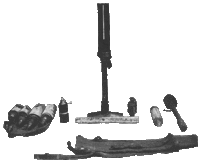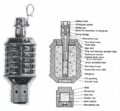Engineering:Type 89 grenade discharger
| Type 89 grenade discharger | |
|---|---|
 Type 89 grenade discharger with various grenades, shells, and accessories | |
| Type | Light mortar |
| Place of origin | Empire of Japan |
| Service history | |
| In service | 1929–1945 by Japan, indeterminate postwar usage by various forces. |
| Used by | See Users |
| Wars | Soviet–Japanese border conflicts Second Sino-Japanese War World War II Indonesian National Revolution Malayan Emergency Korean War First Indochina War Vietnam War |
| Specifications | |
| Mass | 4.7 kg (10 lb 6 oz) |
| Length | 610 mm (24 in) |
| Barrel length | 254 mm (10 in) |
| Cartridge | 793 g (1 lb 12 oz) |
| Calibre | 50 mm (1.97 in) |
| Rate of fire | 25 rpm |
| Effective firing range | (Type 89 shell): 120 m (131 yd) |
| Maximum firing range | (Type 89 shell): 670 m (732 yd) |
The Type 89 grenade discharger (八九式重擲弾筒 Hachikyū-shiki jū-tekidantō), inaccurately and colloquially known as a knee mortar by Allied forces, is a Japanese grenade launcher or light mortar that was widely used in the Pacific Theater of World War II. It got the nickname the "knee mortar" because of an erroneous Allied belief that these launchers could be fired by propping its plate against the leg. However, anyone trying to fire it this way would receive a severe bruise (or sometimes a broken femur) from its hefty recoil.[1]
Background
The Japanese Army, noting that grenades were short-ranged weapons, began efforts to optimize these weapons for close-in infantry fighting. After studying employment of grenades and mortars on the battlefield, the Japanese Army developed hand grenades, rifle grenades, and grenade and mortar shell dischargers (small mortars) suited to warfare in typical short-range combat environments such as urban, trench, and jungle warfare.
As part of this effort, the Japanese Army had adopted by 1932 a set of fragmentation grenades with almost universal adaptability. The Type 91 fragmentation grenade could be thrown by hand, fired from a spigot-type launcher, or used in a mortar-like grenade discharger, the Type 89.[2]
Design and operation
The Type 89 heavy grenade discharger was adopted in 1929, but production did not begin until 1932. It differs from the earlier Type 10 grenade discharger in that it has a rifled barrel. The Type 89 could fire two types of grenades or shells: the Type 91 grenade, which was a normal infantry fragmentation grenade adapted to the Type 89 discharger, and the Type 89 50 mm shell, which was an impact-detonated shell with considerably more explosive power.
When fired from the Type 89 discharger, the Type 91 fragmentation grenade was fitted with a propellant base and time fuse. It did not explode upon contact, but was designed to ignite its fuse while in flight. A weak creep spring inside the grenade firing mechanism allowed the firing pin to be thrown back upon launching, igniting a time fuse with a 7-8 second delay. Using this system, the Type 91 grenades could be launched through jungle cover or through small openings without the danger of premature detonation in the event the grenade struck an object on its way to the target.[3] Although the Type 89 could be fired by a single person, it was typically operated with a crew of 3, enabling it to reach a rate of fire of about 25 rounds per minute.[4]
The Type 89 discharger could also be used with a more powerful impact-detonated shell approaching the power of a light mortar. Weighing approximately 2 pounds (910 g), it was known as the Type 89 50 mm shell, and was made in high explosive (HE), incendiary and smoke variants. To fire the shell (which had a nose-mounted impact fuse that detonated on contact), it was dropped base-down inside the tube of the discharger. By setting the Type 89 discharger at a fixed angle of 45 degrees, and varying distance to target by adjusting the size of a variable chamber space inside the discharger mechanism (see also the Granatnik wz. 36), soldiers could adjust fire onto multiple targets at varying ranges while firing the contact-detonated 50 mm shell through a single small clearing in the jungle canopy.[5] The method worked equally well when firing from deep trenches or pits, or between various building obstructions when fighting inside a built-up town or city.[5]
With its curved support plate, the Type 89 was designed to be placed on the ground or against a log or trunk at a fixed firing angle of 45 degrees. However, since it used a spring-loaded, lanyard-operated firing pin mechanism, in an emergency it could fire grenades or shells at point targets while braced horizontally against a tree or building.
Combat use
The Imperial Japanese Army issued three Type 89s per platoon, making it their most widely used infantry fire support weapon.[6]
The Type 89 discharger saw service at the Battle of Khalkhin Gol in Manchuria during the Second Sino-Japanese War. During World War II, the weapon was used effectively against the Allied defenders in the Battle of Corregidor in May 1942. It also saw service in Burma and the Pacific islands. Japanese Navy paratroopers carried special containers for the Type 89 clipped to their harnesses to provide fire support right on the landing zone.[1] Allied troops quickly learned to take cover when they heard the weapon's "pop" when launching its grenades or shells, in some cases from more than 200 yd (180 m) away.[2]
After World War II the Type 89 was used by Indonesian National Army and militias against Dutch forces in the Indonesian National Revolution,[7] with copies of the weapon manufactured in Demakijo, Yogyakarta.[citation needed] Others were used by Communist forces during Chinese Civil War and Korean War.[7] Some were also used by the Việt Minh during First Indochina War[8] and by the Viet Cong during the Vietnam War.[7]
Ammunition
- Type 89 50 mm HE (high explosive) mortar shell (fitted with impact detonator) [Weight: ~2.00 lb (0.91 kg)]
- Type 91 fragmentation grenade (fitted with 7 second delay time fuse, ignited in flight)
- Type 94 50 mm practice shell
- Smoke shell weight: 0.9 kg containing 0.11 kg of HC type smoke mixture
- Incendiary shell weight: 0.57 kg containing 0.32 kg of incendiary material
Users
 China[7]
China[7] Japan: Imperial Japanese Army
Japan: Imperial Japanese Army Indonesia: Indonesian National Army[7]
Indonesia: Indonesian National Army[7] North Korea[7]
North Korea[7] South Korea[7]
South Korea[7] Vietnam[7]
Vietnam[7]
Notes
- ↑ 1.0 1.1 Norris, John (2002). Infantry Mortars of World War II. Osprey. p. 47. ISBN 1841764140. https://archive.org/details/infantrymortarsw00norr.
- ↑ 2.0 2.1 George, John B. (LTC) (1981). Shots Fired In Anger. NRA Press. p. 343. ISBN 0-935998-42-X.
- ↑ George, John B. (LTC) (1981). Shots Fired In Anger. NRA Press. p. 350. ISBN 0-935998-42-X.
- ↑ "Japanese Ordnance Material of WW II". http://www.wlhoward.com/museum/id577.htm.
- ↑ 5.0 5.1 George, John B. (LTC) (1981). Shots Fired In Anger. NRA Press. p. 359. ISBN 0-935998-42-X. "By using a fixed firing angle for the discharger, combined with a variable chamber, the Japanese were able to fire the 50 mm Type 89 shell to varying distances through small clearings above the discharger by adjusting the maximum height of trajectory."
- ↑ Diamond, Jon (2015). Chindit vs Japanese Infantryman 1943-1944. Osprey Publishing. pp. 23.
- ↑ 7.0 7.1 7.2 7.3 7.4 7.5 7.6 7.7 "Mukden Arsenal after WWII". April 3, 2017. https://wwiiafterwwii.wordpress.com/2017/04/03/mukden-arsenal-after-wwii/.
- ↑ Windrow, Martin (September 20, 2018). French Foreign Légionnaire vs Viet Minh Insurgent: North Vietnam 1948–52. Combat 36. Osprey Publishing. p. 42. ISBN 9781472828910.
References
- Leo J. Daugherty III, Fighting Techniques of a Japanese Infantryman 1941–1945, ISBN:1-86227-162-3
- Gordon L Rottman, Japanese Infantryman 1937-45 Sword of the empire, ISBN:1-84176-818-9
- US Army field manual TM-E 30-480 at hyperwar
- Taki (Type 89)
- U.S. World War II Intel Report on Japanese Smoke Grenades
See also
- Chinese Type 27
- Commando mortar, a class of infantry light mortars designed for maximum portability and rapid deployment, at the expense of accuracy and rate of fire.
- Lance-grenade individuel Mle F1 (LGI Mle F1), a French close-support weapon infantry weapon designed to be used by one man
External links
- Nambu World: Type 89 “Knee Mortar” (Grenade Launcher)
- Type 91 grenade at inert-ord.net
- Type 89 grenade at inert-ord.net
- Colour pictures of the Type 89 and Type 10 at carbinesforcollectors.com
 |





